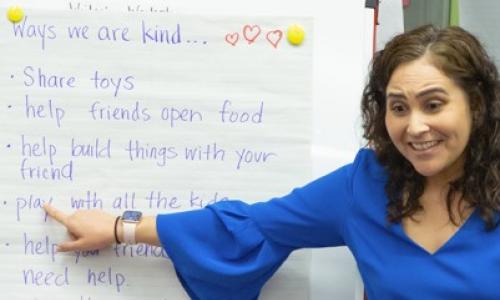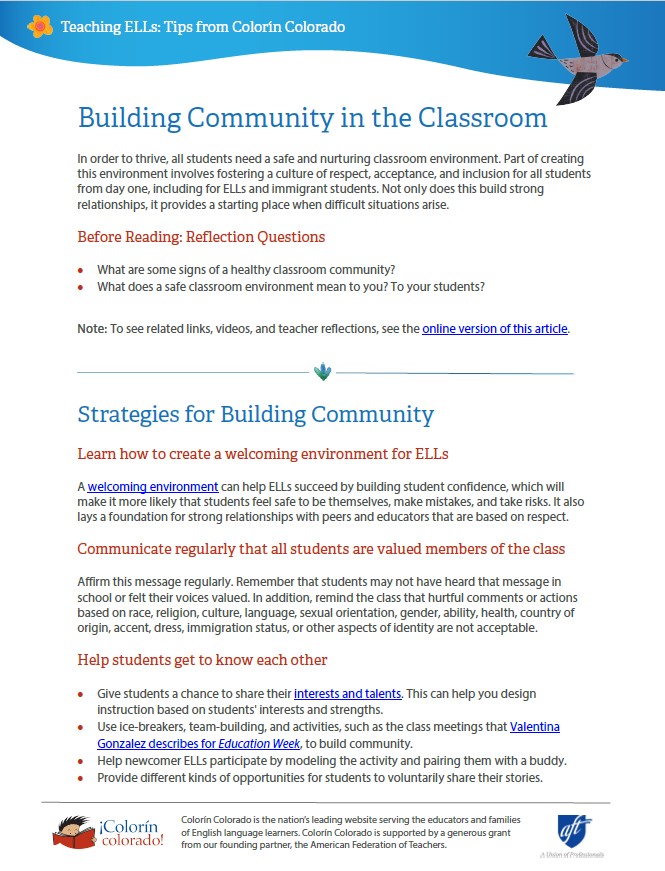Creating Shared Expectations in the Classroom

Learn what experienced educators suggest for creating shared expectations in the classroom around respectful behavior and managing conflict. This article is part of Navigating Tough Topics in the Classroom: Tips for ELL Educators.
Photo by Allison Shelley for EDUimages
Acknowledgements
 This project was made possible with support from the American Federation of Teachers.
This project was made possible with support from the American Federation of Teachers.
In order to build a healthy classroom community, it is essential to create a set of shared expectations around how students interact with each other and behave. At the same time, there are many steps educators can take to ensure that English language learners (ELLs) are actively engaged in that process and that their cultures and languages are reflected in the classroom culture. These efforts can go a long way in minimizing and navigating conflicts.
This article offers a number of ideas around this process, as well as recommended resources with additional examples and tips.
 Before Reading: Reflection Questions
Before Reading: Reflection Questions
- Have you been in a situation where you had to navigate a new culture?
- What lessons did you take from that experience?
Creating Classroom Guidelines
Encourage students to take ownership of the classroom culture
Ask students to answer the following questions through drawings or written responses.
- How can I be a good classmate to others?
- What are examples of kind and respectful behavior in the classroom?
- What are examples of unkind or disrespectful behavior in the classroom?
To support ELLs in their discussions of these questions:
- Encourage students who speak the same language to discuss their ideas in groups.
- Provide scaffolded materials such as graphic organizers, sentence stems, and sentence frames.
- Use a picture book to talk about different kinds of behavior with students.
You may wish to ask older school students to anonymously share their thoughts on questions such as:
- What does a safe (or brave) space mean to me?
- A time I felt safe / unsafe in the classroom was...
- Talking about (topic) makes me feel...
Create a shared list of classroom expectations together
To create a shared list of classroom expectations:
- Return to your earlier discussion of what a respectful classroom looks like.
- Brainstorm ideas on possible class rules based on that discussion.
- Streamline the list of class guidelines or rules. Add any rules or guidelines that are missing.
- Post the final list of classroom rules in the classroom. Translate the rules into ELLs’ native languages.
- Use visuals and modeling to support ELLs' understandings of routines and expectations.
For example, see Carol Salva’s process for developing a community contract each year.
Related resources
- Creating Class Rules: A Beginning to Creating Community (ReadWriteThink)
- Ten Activities for Establishing Classroom Rules (Education World)
- A New Set of Rules: Creating a “Class Constitution” (Teaching Tolerance)
- Creating Classroom Rules with a Bill of Student Rights (Edutopia)
- Creating a Classroom Contract (Facing History)
- Creating a Community Contract (Carol Salva)
Make sure students and families understand policies related to bullying
As part of this process, ensure that you, students, and families are clear on rules regarding bullying by:
- Familiarizing yourself with your district’s bullying policy and ensuring that families have it in their language
- Sharing examples of what bullying looks like in person and online
- Explaining that no one should be bullied for any reason, including language, accent, country of origin, cultural customs, food, dress, or immigration status
- Sharing examples of being a bystander and an upstander
- Taking reports of bullying seriously and reporting incidents to administrators
- Determining whether an incident reflects a larger trend that needs to be addressed by the whole staff
- Learning how to prevent the bullying of ELLs
Resources
- How to Address Bias and Bullying: Resources for Schools
- 8 Tips to Protect ELLs from Bullying in Your Classroom and School
The Role of Culture
Be mindful of the ways in which culture may impact student behavior
Students’ behaviors are shaped by their culture, and ELLs may be learning new cultural norms here in the U.S. In addition, students bridging different cultures may need guidance on which behaviors are appropriate in which setting.
- Try to learn a little bit more about the cultural norms of your students, especially those related to schooling. You can learn more about the "culture of school" and other ways to develop culturally sustaining practices in Culturally Responsive Teaching for Multilingual Learners (Corwin, 2021).
- Keep in mind that cultural norms may differ around eye contact, physical proximity and contact, gestures, talking about appearance, using profanity, and physical punishment.
- If you have questions about a student's behavior, talk with a cultural liaison or ESL teacher to learn more about appropriate responses and ideas for helping students navigate a new culture.
For example, in this Colorín Colorado article on partnering with Ukrainian families, Ukrainian teachers share some of the questions Ukrainian families and students commonly have when they come to the U.S.
Keep in mind the differences between collectivist and individualistic cultures
It's also important to keep in mind the differences between collectivist (group-oriented) and individualistic cultures and how those dynamics can shape interactions with students and families. Students and families from collectivist cultures may prefer working in groups and attending group events at the school, such as group teacher-parent conferences.
Supporting Social and Emotional Learning
Give students tools for expressing emotions and managing conflict
Help students learn skills that will allow them to handle emotions and conflict more effectively, such as:
- building their emotional vocabulary through visuals, charts, mood meters, and regular check-ins
- creating calm corners or spaces in the classroom where they can calm down as needed
- teaching tools for mindfulness and stress relief, such as breathing exercises or visualizations
- giving age-appropriate students tools for conflict resolution, such as a sheet of emojis or list of translated phrases
- talking about how conflict is handled in different cultures and what students have observed about conflict resolution in their culture (this could also be a topic for family interviews)
- asking students what they do when they feel stress, anger, sadness, or other difficult emotions
- offering ideas for managing difficult emotions and providing opportunities to practice these activities, like taking a couple of deep breaths, sitting in a quiet corner to cool down, drawing or writing, exercising, talking to a friend or trusted adult, or movement/brain breaks
- practicing responses through role play
- inviting a school counselor into the classroom to lead a class discussion and share strategies
You can see more ideas in the following articles:
- SEL for English Language Learners: What Educators Need to Know
- 10 Strategies for Supporting SEL for ELLs: "Grow As You Go"
- Setting the Tone for the Day, for the School, for the District Through Social Emotional Learning
Reflect on Your Role and Responses
Your role in the classroom community is shaped by your own experiences, identity, and implicit biases.
- Take some time to reflect on how your perspective may impact your interaction with students and whether there are some areas you would like to explore further.
- Think about how you might respond when students engage in disrespectful behavior or language.
- Even though you can’t anticipate every conflict that will arise in your classroom, giving some prior thought will help you be more prepared to address whatever does occur.
Some phrases you might use in response to a hurtful comment are:
- “Let’s pause and remember our class guidelines. We want everyone to feel safe in our classroom. I’m betting that not everyone feels safe right now.”
- “Did you mean to say something hurtful when you said that?”
- “What did you mean by that?”
- “Using that word doesn’t help others feel safe or accepted here.”
In addition, consider some of the factors that might influence student behavior, such as cultural considerations, language, different emotions, factors at home, level of challenge. When you know the reason for behavior, you can better address the root causes and provide support to reduce the undesired behavior.
For example, is a child:
- Frustrated?
- Hungry?
- Acting in alignment with home culture?
- Being bullied?
- Needing more attention or challenge?

